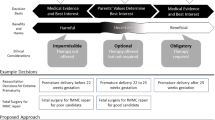Abstract
Background
The results of the Management of Myelomeningocele Study (MOMS) randomized controlled trial have demonstrated that maternal-fetal surgery (MFS) for myelomeningocele (MMC) compared to postnatal MMC repair has clear neurological benefits for the child at 12 and 30 months of age. Level I evidence nevertheless does not provide answers to many questions in this delicate field. Since the beginning of 2012, our fetal center has been offering MFS for spina bifida aperta (SBA) to patients from different European and non-European countries, in a societal context where termination of pregnancy is the option chosen by most patients when being informed of this diagnosis.
Methods
We aim to explore in this text some of the ethical, legal, and psychological issues that we have encountered.
Results
For many of these questions, we do not have definite answers. A pregnant patient when diagnosed with a MMC fetus is a vulnerable subject. She needs to be referred to a highly specialized center with sufficient expertise in diagnosis and in all therapeutic options. Objective but compassionate counseling is of paramount importance. It is required that a multidisciplinary professional team obtains full voluntary consent from the mother after providing an appropriate information including diagnosis, short-, medium-, and long-term prognosis as well as benefits and harms of the fetal surgery.
Conclusion
The latter should be offered with full respect for maternal choice and individual assessment and perception of potential risks taking into consideration legislation in the fetal center and the parents’ country legislation.
Similar content being viewed by others
References
Adzick NS, Thom EA, Spong CY, Brock JW 3rd, Burrows PK, Johnson MP, Howell LJ, Farrell JA, Dabrowiak ME, Sutton LN, Gupta N, Tulipan NB, D’Alton ME, Farmer DL, MOMS Investigators (2011) A randomized trial of prenatal versus postnatal repair of myelomeningocele. N Engl J Med 364:993–1004
Bakaniene I, Prasauskiene A, Vaiciene-Magistris N (2016) Health-related quality of life in children with myelomeningocele: a systematic review of the literature. Child Care Health Dev 42:625–643
Brock JW 3rd, Carr MC, Adzick NS, Burrows PK, Thomas JC, Thom EA, Howell LJ, Farrell JA, Dabrowiak ME, Farmer DL, Cheng EY, Kropp BP, Caldamone AA, Bulas DI, Tolivaisa S, Baskin LS, MOMS Investigators (2015) Bladder function after fetal surgery for myelomeningocele. Pediatrics 136:e906–e913
Bruner JP, Richards WO, Tulipan NB, Arney TL (1999) Endoscopic coverage of fetal myelomeningocele in utero. Am J Obstet Gynecol 180:153–158
Cohen AR, Couto J, Cummings JJ, Johnson A, Joseph G, Kaufman BA, Litman RS, Menard MK, Moldenhauer JS, Pringle KC, Schwartz MZ, Walker WO Jr, Warf BC, Wax JR, MMC Maternal-Fetal Management Task Force (2014) Position statement on fetal myelomeningocele repair. Am J Obstet Gynecol 210:107–111
Deprest J, Toelen J, Debyser Z, Rodrigues C, Devlieger R, De Catte L, Lewi L, Van Mieghem T, Naulaers G, Vandevelde M, Claus F, Dierickx K (2011) The fetal patient—ethical aspects of fetal therapy. Facts Views Vis Obgyn 3:221–227
Eurocat network. Neural tube defects (per 10,000 births): all registries, last 5 years, 2008–2012. http://www.eurocat-network.eu/default.aspx. Accessed 3 Jul 2016
Garne E, Dolk H, Loane M, Boyd PA (2010) EUROCAT website data on prenatal detection rates of congenital anomalies. J Med Screen 17:97–98
Heffez DS, Aryanpur J, Hutchins GM, Freeman JM (1990) The paralysis associated with myelomeningocele: clinical and experimental data implicating a preventable spinal cord injury. Neurosurgery 26:987–992
http://www.un.org/en/universal-declaration-human-rights/index.html. Accessed 3 Jul 2016
https://en.wikipedia.org/wiki/Nasciturus_pro_iam_nato_habetur,_quotiens_de_commodis_eius_agitur. Accessed 3 Jul 2016
Joyeux L, Engels AC, Russo FM, Jimenez J, Van Mieghem T, De Coppi P, Van Calenbergh F, Deprest J (2016) Fetoscopic versus open repair for spina bifida aperta: a systematic review of outcomes. Fetal Diagn Ther 239:161–171
Kancherla V, Druschel CM, Oakley GP Jr (2014) Population-based study to determine mortality in spina bifida: New York State congenital malformations registry, 1983 to 2006. Birth Defects Res A Clin Mol Teratol 100:563–575
Kohl T, Hering R, Heep A, Schaller C, Meyer B, Greive C, Bizjak G, Buller T, Van de Vondel P, Gogarten W, Bartmann P, Knopfle G, Gembruch U (2006) Percutaneous fetoscopic patch coverage of spina bifida aperta in the human—early clinical experience and potential. Fetal Diagn Ther 21:185–193
McLone DG, Dias MS (2003) The Chiari II malformation: cause and impact. Childs Nerv Syst 19:540–550
Oakeshott P, Hunt GM, Poulton A, Reid F (2010) Expectation of life and unexpected death in open spina bifida: a 40-year complete, non-selective, longitudinal cohort study. Dev Med Child Neurol 52:749–753
Olesen JD, Kiddoo DA, Metcalfe PD (2013) The association between urinary continence and quality of life in paediatric patients with spina bifida and tethered cord. Paediatr Child Health 18:e32–e38
Ovaere C, Eggink A, Richter J, Cohen-Overbeek TE, Van Calenbergh F, Jansen K, Oepkes D, Devlieger R, De Catte L, Deprest JA (2015) Prenatal diagnosis and patient preferences in patients with neural tube defects around the advent of fetal surgery in Belgium and Holland. Fetal Diagn Ther 37:226–234
Rocque BG, Bishop ER, Scogin MA, Hopson BD, Arynchyna AA, Boddiford CJ et al (2015) Assessing health-related quality of life in children with spina bifida. J Neurosurg Pediatr 15:144–149
Vinck A, Nijhuis-van der Sanden MW, Roeleveld NJ, Mullaart RA, Rotteveel JJ, Maassen BA (2010) Motor profile and cognitive functioning in children with spina bifida. Eur J Paediatr Neurol 14:86–92
Wang JC, Lai CJ, Wong TT, Liang ML, Chen HH, Chan RC et al (2013) Health-related quality of life in children and adolescents with spinal dysraphism: results from a Taiwanese sample. Childs Nerv Syst 29:1671–1679
Wilson RD, Lemerand K, Johnson MP, Flake AW, Bebbington M, Hedrick HL, Adzick NS (2010) Reproductive outcomes in subsequent pregnancies after a pregnancy complicated by open maternal-fetal surgery 1996–2007. Am J Obstet Gynecol 203:209 e1–6
Author information
Authors and Affiliations
Corresponding author
Ethics declarations
Conflict of Interest
No conflict of interest
Rights and permissions
About this article
Cite this article
Van Calenbergh, F., Joyeux, L. & Deprest, J. Maternal-fetal surgery for myelomeningocele: some thoughts on ethical, legal, and psychological issues in a Western European situation. Childs Nerv Syst 33, 1247–1252 (2017). https://doi.org/10.1007/s00381-017-3446-6
Received:
Accepted:
Published:
Issue Date:
DOI: https://doi.org/10.1007/s00381-017-3446-6




